The SESGD Standard: A Framework for Evaluating Educational Blockchains
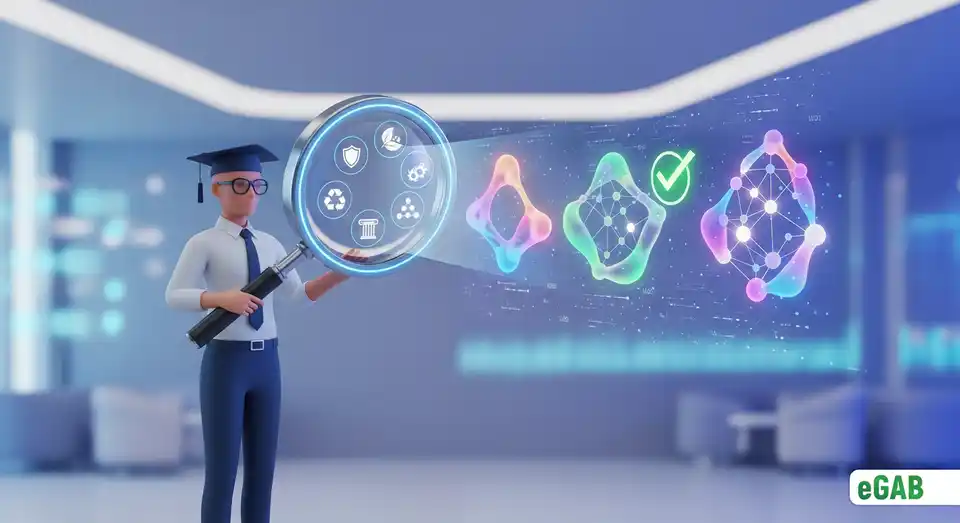
 Author:
Artem Grigoriev
Author:
Artem Grigoriev
Trying to choose the right blockchain for your university’s digital diplomas can feel overwhelming, can't it? With countless platforms all claiming to be the best, how can you be sure which one is truly secure, cost-effective, and compliant with critical regulations like GDPR? Picking the wrong technology isn't just a financial mistake-it can seriously risk your student data and undermine the global recognition of your credentials.
That’s the exact problem the SESGD Standard was designed to solve. It’s a comprehensive framework created specifically for the objective quality assessment of educational blockchains . It provides a clear, detailed set of criteria to evaluate the platforms you use for issuing and managing vital digital credentials . In this article, we'll break down exactly what the SESGD Standard is, explore its key evaluation criteria , and show you how it provides a clear, reliable method for choosing a solution that is truly secure, effective, and ready for the global stage.
Why Do We Need a Standard for Evaluating Educational Blockchains?
Switching to digital educational credentials and using blockchain is a game-changer. It means you can instantly verify qualifications and have them recognized anywhere in the world. While that's incredibly convenient, new opportunities always bring new challenges . The biggest ones we face are:
- How can you ensure trust in a digital credential when diploma forgery is a multi-million dollar industry?
- How do you protect the security of student data and comply with strict laws like GDPR?
- How can you make the whole process efficient and affordable?
- And how do you correct simple human errors in a system where records are permanent?
To solve these problems, we needed a clear standard. That's why we created one within The Global Digital Credentials Management Program, which is built on 12 foundational principles designed to ensure every credential is secure, easy to use, and recognized internationally.
The standards that already existed just didn't cut it. They took a purely technical approach and completely missed the specific needs of education-like costs, practical benefits, and the importance of global compatibility, an issue being tackled by organizations like UNESCO through its Global Convention on the Recognition of Qualifications .
So, we decided to create a new standard-one that lets educational institutions objectively compare different blockchains not just as technology, but as part of the complete educational credential ecosystems they operate in . This helps you look past the "shiny package" and avoid making a choice you'll regret.
Today, the market is flooded with blockchains, and every developer will tell you theirs is the best. When you're choosing a blockchain, it's critical to look beyond the tech itself. You need to evaluate the entire academic credential ecosystem to make sure it's not just trendy, but actually secure, practical, user-friendly, and cost-effective.
This is exactly why we developed the SESGD Standard . It gives you a clear set of criteria to evaluate how well a specific blockchain and its ecosystem are suited for working with educational credentials. In this article, we'll break down in simple terms what SESGD is, why it matters, and how it helps you choose the right, reliable solution.
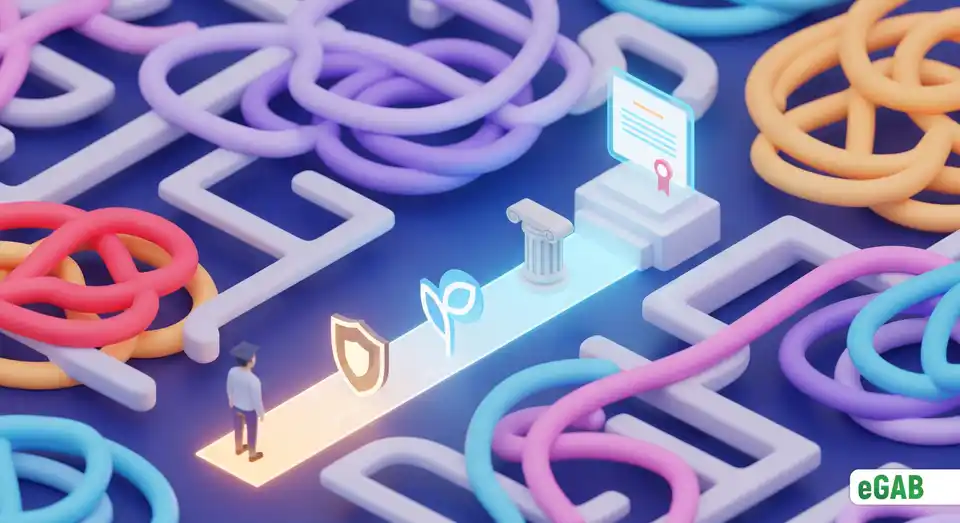
What is the SESGD Standard?
To fairly judge blockchain solutions in education, we needed a unique, specialized standard. That standard is SESGD .
The SESGD Standard is a set of clear criteria designed specifically for the objective evaluation of blockchain platforms and the ecosystems in which they operate. Its purpose is to identify the most suitable solutions for issuing and managing digital diplomas, certificates, awards, and other academic credentials.
To make sure the SESGD standard is genuinely useful, we built it on several key principles:
- Specialization for Education: The standard gets that academic credentials aren't cryptocurrencies or shipping manifests. They have their own unique requirements, and SESGD puts those needs first, always.
- Security: Protecting personal data and preventing fraud is our top priority, but we also make sure the encryption methods and computing power it requires are practical for everyday use.
- Efficiency and Accessibility: A solution has to be more than just reliable. It needs to be affordable and easy for people to use every day.
- Global Focus: We designed it to ensure credentials are recognized internationally and work seamlessly (interoperability) across different countries.
- Transparent Evaluation: The way we judge systems has to be clear and make sense to everyone involved.
You can look at the SESGD standard from a few different angles:
- For an educational institution: Think of SESGD as your decision-making tool. It helps you pick a technology and platform for digital credentials that's reliable, secure, affordable, and user-friendly, all while making sure your credentials will be accepted anywhere in the world.
-
By what it measures (the acronym explained):
- S is for Security
- E is for Ecology and Efficiency - We look at everything from the energy consumption of its algorithms (like Proof-of-Work vs. Proof-of-Stake) to its overall performance.
- S is for Sustainability - Is the system built to last for the long haul?
- G is for Governance - How well is the platform managed and supported?
- D is for Decentralization - How independent is it from a single point of control or failure?
- As a blueprint for global education ("Standard for Educational System Global Digitization"): SESGD sets the gold standard for the digital transformation of educational systems. It ensures different systems are compatible, secure, and recognized internationally, helping create a single, trusted digital space for academic achievements.
-
As a checklist for a modern platform (an alternative view as a "Secure, Efficient, Scalable, Globally-compliant, Data-centric Standard"):
SESGD defines what any top-tier system for educational credentials must be:
- Secure: With rock-solid data protection.
- Efficient: Fast and affordable to run.
- Ecological: With a minimal environmental footprint.
- Scalable: Ready to grow as your needs grow.
- Globally-compliant: Works and is recognized everywhere.
- Data-centric: Focused on managing information correctly and reliably.
- For the end-user (student, employer): Simply put, SESGD is a stamp of quality and trust . If a system has a high SESGD rating, it means you can trust its credentials. They're securely protected and easy to verify.
The main goal of the SESGD standard is to offer a complete, 360-degree way to evaluate blockchain solutions and their ecosystems. We look at everything-from cryptographic security to cost and global compatibility-to find the most effective, practical, and user-friendly solution out there. The need for this big-picture approach is backed up by reports like the European Parliament's study "Blockchain in Education" , which highlights that technology is only one piece of the puzzle; management and ethics are just as important.
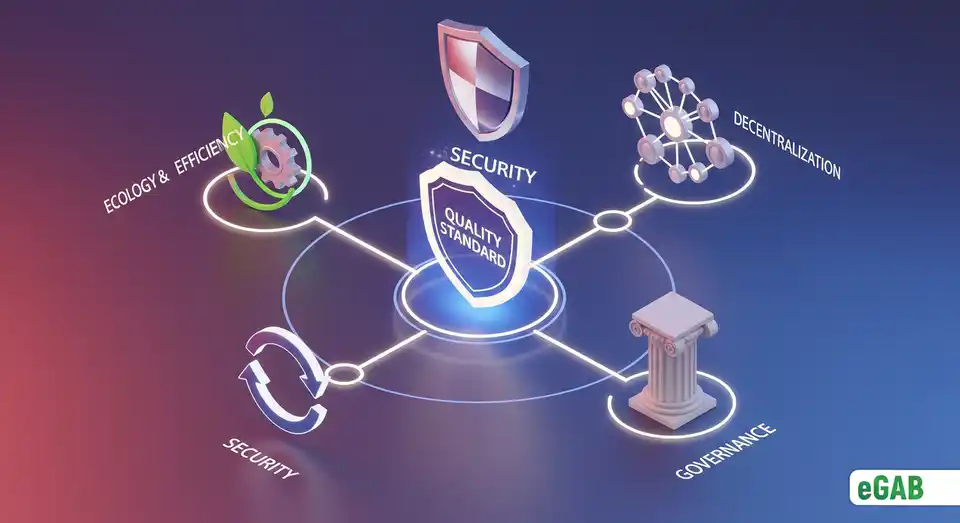
General-Purpose vs. Specialized Blockchains: Why Does Education Need a Custom Solution?
We've already talked about why a special standard like SESGD is vital for checking if a blockchain system is right for education. Now, let's tackle a big question: why can't we just grab a well-known, "general-purpose" blockchain and use it for diplomas and certificates? After all, there are plenty of them, and they seem to work just fine in other industries.
The SESGD standard is the perfect tool to help us see how well any solution-whether it's general-purpose or specialized-actually handles the unique challenges of education.
The Problems with General-Purpose Blockchains for Education
Many popular blockchains, like Ethereum, Binance Smart Chain, Polygon, or even Bitcoin with its Ordinals, were designed to do a bit of everything: handle financial transactions, launch cryptocurrencies, and run complex decentralized apps (dApps). But when you try to apply these "jacks-of-all-trades" to education, you run into the same problems over and over again:
-
They're Expensive and Unpredictable: Recording a single credential on a public blockchain can be costly. Worse, transaction fees (or "gas fees") on these networks swing wildly depending on how busy they are, making it impossible to budget. Imagine paying $2 to issue a credential today, only to see the price jump to $25 tomorrow because of a spike in network activity.
-
They Can Be Outlawed: Almost all general-purpose public blockchains run on cryptocurrencies. In many countries, these are either banned or exist in a legal gray area, creating serious legal risks for educational institutions .
-
They Fail to Meet Data Protection Standards: Trying to fully comply with strict data protection laws like Europe's GDPR (General Data Protection Regulation) on a public blockchain is next to impossible. The permanent, unchangeable nature of these blockchains directly clashes with GDPR's Article 17-the "right to be forgotten," which gives people the right to have their personal data deleted.
-
They Use a Massive Amount of Energy: Blockchains that use the Proof-of-Work (PoW) algorithm need a staggering amount of electricity. According to Digiconomist , the Bitcoin network alone uses as much energy each year as the entire country of the Netherlands. For any school that cares about sustainability , this is a huge ethical and reputational red flag.
-
They're Bloated and Complex: General-purpose blockchains are packed with features that are completely useless for educational credentials. This extra complexity doesn't just make the system clunky; it can also create more security holes and attack vectors for smart contracts (like reentrancy vulnerabilities).
-
Verification and Global Recognition are a Headache: Without a specialized ecosystem built around it, verifying a credential on a general-purpose blockchain is a technical nightmare for the average employer or university. This completely undermines the goal of global recognition .
-
Managing Credentials After They're Issued is Tough: Need to make a change, like revoking a credential for a valid reason? Good luck. Managing credentials on these blockchains is often inflexible and incredibly cumbersome.
-
They Don't Connect to the Educational Ecosystem: These blockchains aren't built to integrate with the tools you already use, like specialized Learning Management Systems (LMS) or career development platforms. This drastically limits how useful they can be in the real world.
-
They Don't Account for Real-World Mistakes: These systems simply weren't designed with the specific errors and practical situations that schools deal with every day when handling credentials.
This is exactly why general-purpose blockchains can't meet the specific needs of education. It's why we critically need specialized blockchain solutions built from the ground up for the academic world.
Learn more: Why Public NFT Platforms Are a Poor Fit for Academic Credentials
A purpose-built solution like CREST Chain, which is the engine behind the eGAB ecosystem, was designed from day one to solve all these problems:
- Near-Zero Costs: Its optimized architecture makes transactions practically free.
- Fully Compliant with Local Laws: It was built to work within the laws of any country, even those that have banned cryptocurrencies.
- Built for GDPR: Its design includes mechanisms from the start to protect personal data and honor the "right to be forgotten."
- Incredibly Energy-Efficient: It uses hundreds of millions of times less energy than Proof-of-Work blockchains.
- Lean and Secure Architecture: It has no unnecessary features-only what's needed for the secure management of diplomas and certificates.
- Works Within a Trusted Ecosystem: Credentials can be verified instantly and globally through the Credly.study platform, which serves as a Trusted Third Party (TTP), while its issuers are verified by a Certificate Authority (CA).
- Simple Post-Issuance Management: It comes with flexible tools that make managing credentials easy.
- Connects with Your Tools: It's designed to be part of the educational credential ecosystem and easily integrates with your institution's other services.
- Designed from Practical Experience: It was developed based on years of real-world experience and a deep understanding of what educational institutions actually need.
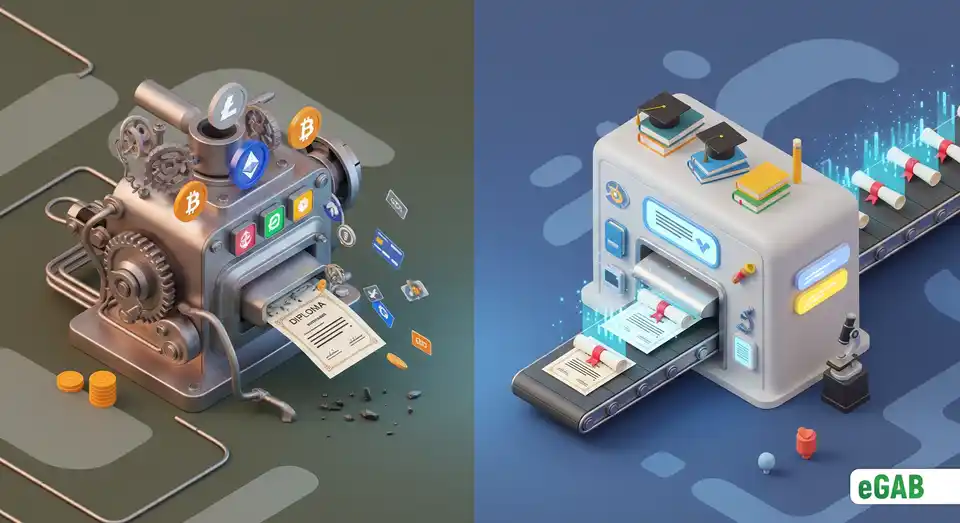
SESGD Standard Evaluation Criteria
The SESGD standard doesn't just look at the blockchain itself. We evaluate the entire socio-technical ecosystem it operates in to tackle the real-world challenges of issuing educational credentials in NFT format.
Our goal isn't just to check boxes on a technical spec sheet. We need to understand how reliable, secure, effective, and user-friendly the entire solution is in practice. We calculate the final score as a weighted sum of all criteria, out of a possible 100 points.
A key principle for us is reasonable sufficiency . This means an overly complex or expensive solution, even if it's technically advanced, will score lower than a simpler one that just works and effectively solves the specific tasks of issuing educational credentials.
The scores can also shift depending on the specific challenges and goals of your particular educational institution.
SESGD Evaluation Criteria and Their Weight in the Overall Score (100 Points Maximum):
- Cryptographic reliability and complete protection against unauthorized access (following industry best practices like NIST standards) (7 points).
- A system architecture that minimizes the risk of attacks and personal data breaches (7 points).
- Guaranteed immutability of educational credentials on the blockchain (Data Integrity) (7 points).
- A specialized blockchain architecture that’s optimized for educational credentials (7 points).
- The blockchain's energy efficiency and how it minimizes its environmental footprint (5 points).
- Speed and predictability of transaction processing for both issuance and verification (5 points).
- The system's ability to scale for educational needs, like mass issuances (5 points).
- Economic efficiency and return on investment: predictability and minimizing costs, including transaction fees (7 points).
- The presence of a comprehensive, integrated, turnkey ecosystem (blockchain, platform, TTP, CA) (7 points).
- Long-term sustainability of the solution, including support plans, data storage reliability, and resilience to new technologies (6 points).
- The quality of ecosystem governance and the availability of specialized tech support for educational institutions (5 points).
- Developer transparency, a clear focus on education, and proof of practical experience built into the solution (3 points).
- Intuitive design, simplicity, and ease of use (UX) for all users of the platform (4 points).
- Platform functionality, including tools for customization, mass issuance, and access management (3 points).
- System accessibility from various devices and for people with special needs (2 points).
- The simplicity, speed, and reliability of the credential verification process for third parties through a dedicated interface (5 points).
- Compliance with international and national laws on personal data protection (e.g., GDPR, FERPA, etc.) (5 points).
- Guaranteed legal compliance and independence from cryptocurrency, so it can operate in countries with restrictions (7 points).
- Support for interoperability standards for global compatibility, like the W3C Verifiable Credentials Data Model (1 point).
- An appropriate degree of decentralization that balances security, manageability, accountability, and independence for educational credentials (2 points).
Keep in mind, we can adjust the weight of certain criteria-and therefore the final scores-to match the specific tasks and priorities set by your institution.
So, we've laid out the criteria the SESGD standard uses to evaluate blockchain solutions for education. But what does this assessment actually look like in practice, and what do the final scores really mean?
An SESGD evaluation isn't about running through a formal checklist. It's a deep, multi-stage analysis that covers several key areas:
1. Detailed Technical Audit:
- Blockchain Architecture Analysis: We examine how well the architecture (e.g., private, public, consortium) is suited for storing and managing educational credentials, checking its reliability and potential vulnerabilities.
- Cryptographic Protocol Review: We assess the strength of the encryption algorithms, key management methods, and overall cryptographic security.
- Smart Contract Analysis (if used): We check the logic, security, and efficiency of smart contracts using recognized standards like the Smart Contract Security Verification Standard (SCSVS) .
- Security Mechanism Assessment: We study the measures protecting against common web vulnerabilities (per the OWASP Top 10 ), unauthorized access, data tampering, DDoS attacks, and other cyber threats.
2. Comprehensive Performance and Scalability Testing:
- Transaction Speed Tests: We measure the time it takes to issue (mint) a single credential or a large batch, as well as the speed of verification.
- Scalability Testing: We simulate high-load scenarios (like issuing diplomas to thousands of students at once) to see if the system's performance holds up.
- Load Resistance Evaluation: We analyze how the system behaves under peak loads to identify any risks of failure or major performance drops.
3. Thorough Analysis of Compliance with Norms and Standards:
- Legal Review: We assess the solution's compliance with national and international laws on education and data privacy (like GDPR and FERPA), paying close attention to how student data is stored and processed.
- Interoperability Check: We analyze support for open standards like W3C Verifiable Credentials and Open Badges , which ensure credentials can be recognized across different systems and countries.
- Analysis of Legal Compliance in Restricted Countries: We verify whether the system can operate in places with restrictions on cryptocurrency or specific rules for digital assets.
4. Evaluation of User Experience (UX) and Platform Functionality:
- Interface Testing: We analyze how intuitive, easy, and convenient the platform is for everyone who uses it (administrators, students, and employers).
- Functionality Review: We assess whether all the necessary tools are available for the entire credential lifecycle: from customization and mass issuance to managing access and verification.
- Accessibility Analysis: We check the platform’s adaptability for different devices and its compliance with international standards like the Web Content Accessibility Guidelines (WCAG) for people with special needs.
5. Review of the Economic Model and Long-Term Sustainability:
- Total Cost of Ownership (TCO) Analysis: We look at not only the direct costs (like transactions and subscriptions) but also the indirect ones-implementation, support, updates, and staff training.
- Developer/Operator Business Model Assessment: We analyze pricing transparency, the existence of long-term development and support plans, and the company's overall financial stability.
- Energy Efficiency Check: We take the environmental impact into account, especially for blockchains that demand significant computing power.
The Meaning of the SESGD Point System: A Clear Indicator of Quality
After this comprehensive, deep-dive evaluation covering all 20 criteria, the blockchain platform and its ecosystem receive a final score on the SESGD scale (from 0 to 100) . This score isn't just a number-it's a clear indicator of the solution's quality, reliability, and suitability for the specific needs of the education sector.
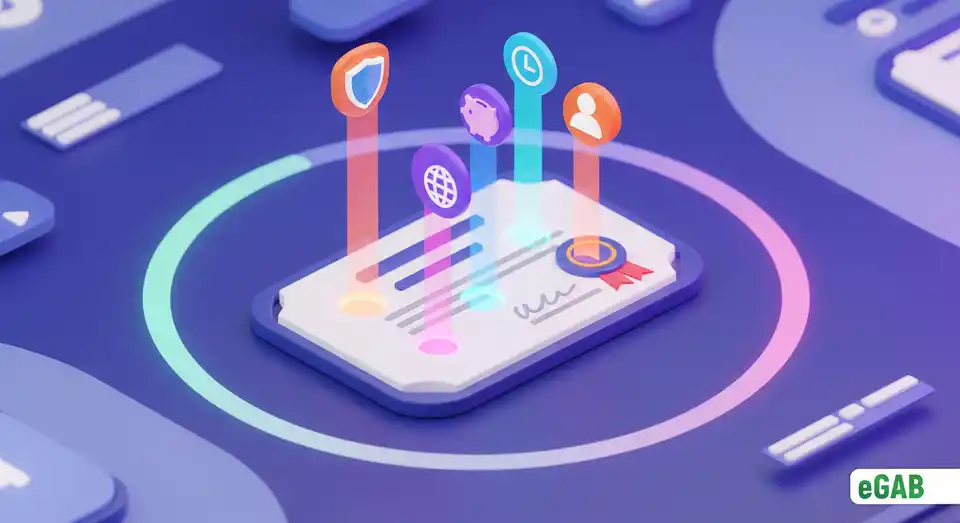
Conclusion: SESGD – Your Key to Selecting Reliable Digital Educational Credentials
In today's world, the move to digital education isn't just a trend-it's an absolute must, especially as the market for digital educational credentials is set to grow exponentially. When you're dealing with something as important as diplomas and certificates, the issues of authenticity and protection against fraud take center stage. So, with countless offerings in the blockchain technology market, how can your institution avoid a costly mistake and choose a truly great solution?
This is exactly why the SESGD Standard exists. In short, SESGD is a comprehensive set of criteria designed to help you thoroughly evaluate blockchain platforms that issue and manage educational credentials. It doesn't just look at the technical details; it assesses the entire system based on the key parameters that really matter:
- Security and personal data protection.
- Efficiency of operation, including speed and cost.
- Sustainability and energy consumption.
- Stability and long-term support for the solution.
- Quality of governance and technical support.
- User-friendliness for everyone involved – from your administrators to employers.
- Compliance with laws and international standards.
- Global compatibility and ease of credential verification.
A standard like SESGD is critically important. It provides educational institutions with the necessary and objective toolkit to analyze their options and make an informed decision, ensuring you invest in a high-quality, reliable, and future-proof solution for your digital credentials.
Focusing on the SESGD standard doesn't just help your institution make a smart choice; it also helps raise the quality and trustworthiness of the entire digital educational credentials industry. This approach aligns with global initiatives to create a transparent and reliable qualifications system, a need highlighted by organizations like the World Economic Forum in its reports on the future of the job market . By choosing platforms that meet the high criteria of SESGD, you're taking a confident step into a safe and effective digital future for your graduates.

